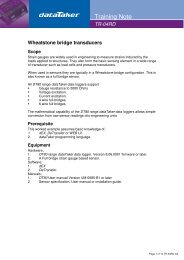Create successful ePaper yourself
Turn your PDF publications into a flip-book with our unique Google optimized e-Paper software.
protocol used to break up and reassemble long messages, not the actual data parameters.)<br />
Examples<br />
SNOOPJ 2<br />
EXT 0CF00400 FE7D7D000000FFFF PGN:61444 PRI:3 SA:0 DA:0<br />
EXT 18FEF000 FFFFFF0000F0CCFF PGN:65264 PRI:6 SA:0 DA:0<br />
EXT 18F0000F C07DFFFF0FFFFFFF PGN:61440 PRI:6 SA:15 DA:0<br />
EXT 0CF00300 F9FE00FFFFFFFFFF PGN:61443 PRI:3 SA:0 DA:0<br />
EXT 18FEF100 FF000050000000C0 PGN:65265 PRI:6 SA:0 DA:0<br />
EXT* 18ECFF00 202E0007FFCAFE00 PGN:65226 PRI:6 SA:0 DA:255 LEN:46<br />
EXT 18FEFF00 FDFFFFFFFFFFFFFF PGN:65279 PRI:6 SA:0 DA:0<br />
EXT* 18ECFF00 20220005FFE3FE00 PGN:65251 PRI:6 SA:0 DA:255 LEN:34<br />
EXT* 18ECFF0F 20130003FFE1FE00 PGN:65249 PRI:6 SA:15 DA:255 LEN:19<br />
END SNOOP<br />
In this example six different single-packet parameter group messages were observed. For each, the PGN, priority, source<br />
address and destination address are returned.<br />
There are also three different multi-packet messages, indicated by EXT*. These include an additional display item: the<br />
length of the data message in bytes. Note that the displayed 64-bit data field does not contain any actual message data; it<br />
contains transport protocol information including PGN and data length.<br />
NETLOAD – Measure CAN Traffic Load<br />
NETLOAD { CANport }<br />
where<br />
CANport is the CAN port to measure (integer, 1-2). If not specified, both CAN ports are measured.<br />
This command measures the traffic load on one or both CAN ports, and reports it as a percentage of the theoretical<br />
maximum for the bit rate in use. It should be noted that a network with a load approaching 80% is close to the practical<br />
maximum load possible on a CAN network.<br />
Examples<br />
NETLOAD<br />
CAN1 0.0 %<br />
CAN2 7.8 %<br />
In this case nothing is connected to CAN1, and a single ECU is connected to CAN2. 7.8% of the available bus bandwidth is<br />
being consumed by the regular broadcasts from this ECU.<br />
SETADDR – Set <strong>CANgate</strong> Address<br />
SETADDR CANport address<br />
where<br />
CANport is the CAN port (integer, 1-2)<br />
<br />
address is the protocol address which <strong>CANgate</strong> should use when communicating on the specified CAN network<br />
(integer, 0-255, default:0)<br />
For some CAN protocols, each device on the network needs to have a unique address assigned. This command allows you<br />
to assign an address to the <strong>CANgate</strong>. Currently this will only have an effect for the J1939 protocol. Note that in most cases<br />
the default address (0) can be used.<br />
GPSBAUD – Set GPS Port Baud Rate<br />
GPSBAUD baudRate<br />
where<br />
baudRate is the required baud rate to use on the GPS port (integer, 300-115200, default:4800)<br />
Most NMEA-0183 devices operate at 4800 baud, however some newer high speed devices operate at a faster rate. This<br />
command allows the GPS port baud rate to be set to match that of the connected device.<br />
The current GPS port baud rate setting is saved to flash memory so it will be restored following a power interruption.<br />
UM-0086-A2 <strong>CANgate</strong> User’s <strong>Manual</strong> Page 25



